The Building of Aslan
Proof of Concept Test
The Building of Aslan |
Proof of Concept Test |
|
|
|
|
|
|
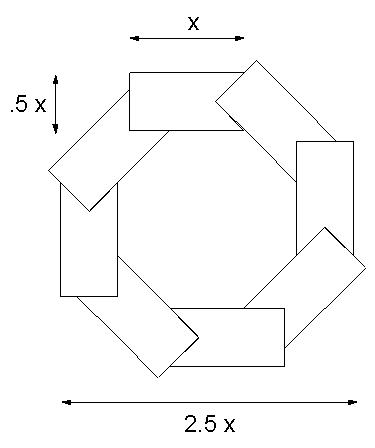 |
Wooden Boat magazine featured
an article in the August/September 1999 issue featuring a "new" method
to make a hollow mast. The basic diagram of a "Bird's Mouth" hollow
mast is at right. Eight pieces of wood "X" wide are ripped
from a board, and then a "bird's mouth" is cut into one end of each by
cutting on a 45 degree angle (deep enough to reach the centerline of the
piece of wood.) In a real bird's mouth assembly, the pieces
(staves, I guess) would be planed down to a thickness that is 1/2 their
width. The finished assembly is 2.5 times the width of each individual
piece.
Remember all those times you thought "I'll never use this in real life" during algebra class? Here is a real life use of "solving for x." If the width of each individual piece is 1", then they should be 1/2" thick, and the finished assembly will be 2 1/2" in diameter. In practice, you'll usually want to make a hollow mast or spar of a
known diameter, but won't know how large to make each individual stave
to end up with that diameter. Just divide that diameter by 2.5.
For instance, to make a hollow mast 3 1/2" in diameter, the "X" dimension
is found by dividing the desired diameter by 2.5:
|
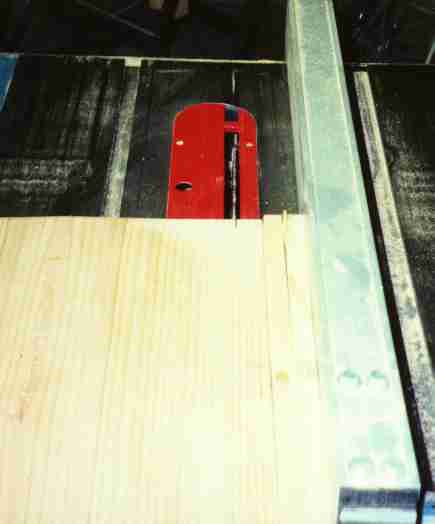 |
My test is to see if a tapered bird's mouth mast can be made.
I haven't received the copy of the Wooden Boat magazine I ordered (www.woodenboat.com).
Using the math above, I calculated that a tapered mast that is 3 3/4" tapering
to 2 1/4" over the final 10' would need to have 8 pieces starting at 1.4"
wide and tapering down to .9" wide at the top. The nearest reasonable
fractional measurement to use for .9" is 7/8".
For the purposes of my test, I chose a much greater taper: 1/8" over 2 feet. I wanted to see if I could taper just one side of the pieces and make a tapered mast. I didn't bother with planing down the dimensional stock to 1/2 the width of each piece; I wanted to see how it affected things to have the pieces too thick (while tapering the width of a piece of wood is easy enough on a table saw with a tapering jig, as shown, but planing the thickness down might be difficult.) |
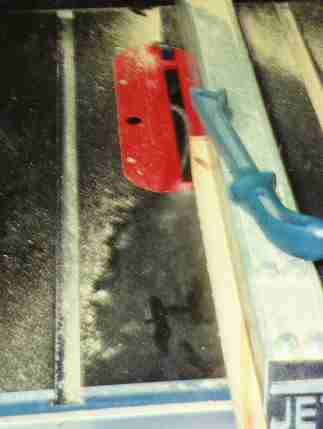 |
After all eight staves have been cut out on the table saw, I quickly set my saw blade to 45 degrees and adjusted the height so that the blade would cut a triangle out of the side when the piece was run through, then flipped end for end, and run through again. Because this was a "proof of concept" test, I didn't bother to verify that the blade was exactly at 45 degrees; I just trusted the angle marker on my table saw (it was off, as we'll see later.) |
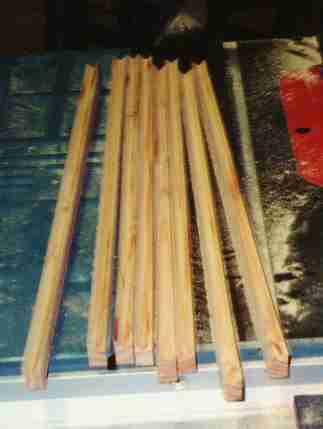 |
Here's 8 finished staves, 1" on one end and 7/8" on the other, with a "bird's mouth" cut into one side. |
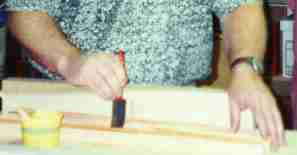 |
I used Weldwood Resin Glue, which would work for a mast assembly. I think epoxy would be a better choice. Glue was spread on each "bird's mouth." |
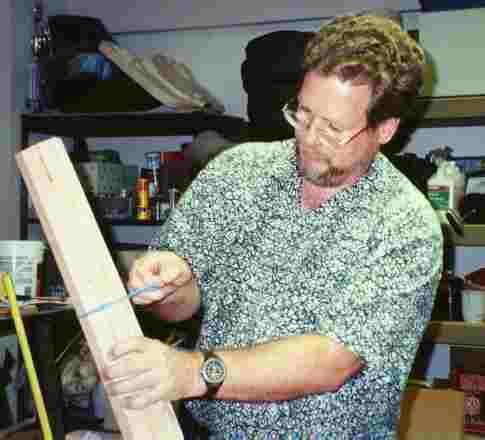 |
For this test, I used rubber bands and plastic wire ties as clamps. It actually worked pretty well. The plastic wire ties, which allow you to "ratchet" the tightness, might be adequate for a 10 foot long assembly, but I doubt it. Terry Crisp, who has some great hints and tips on his Weekender site 9 Lives, tells me the Wooden Boat article reports using hose clamps (you know, the kind you can take apart to slip under the finished assembly.) Rubber bands would be hard to use, as you have to slip them over the end and slide them down the assembly. |
 |
It's hard to see in this picture, but the 2' long "mast" is tapered
nicely. Looking at the ends really shows it (see below.)
In the pictures below, you'll notice that there are gaps where the wood fits together. I think this is because I don't have a true 45 degree angle on the sides of the bird's mouth cut. For a real mast or spar, I would carefully check the measurements and make a trial assembly from scrap. In any case, even this assembly is very strong. I'm anxious to get the copy of the Wooden Boat magazine (they sell back issues on their web site) and see how much detail they go into. There may be other tips there as well. A mast or boom from wood could be made much lighter than a solid one, yet stronger than one glued with 22 1/2 degree edges (the "bird's mouth" really locks the assembly in place.) Thanks to Phil Gowens, who supplied the diagram at the top, Terry Crisp who supplied some more info on clamping, and all the folks at the BYYB bbs. |
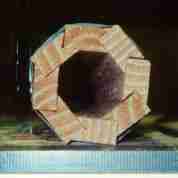 |
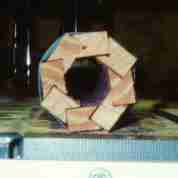 |
The larger end, on the left, and the smaller end on the right.
These pics, even though I tried to take them from the same distance away,
have the size difference exaggerated.
This stock is 3/4" thick instead of 1/2 the width of the pieces . . . which would be 1/2" at the larger end . . . so the protruding corners are much bigger than they should be. Still, I was able to round off the smaller end in very short time using a block plane. |
The Official "Close Enough" Fraction to Decimal Inch Conversion Table
|
|
|
|
|
|
|
|
|
|
|
|
|
|
|
|
|
|
|
|
|
|
|
|
|
|
|
|
|
Weekender Mast and Boom Conversions:
Mast: 3 1/2" square for 30" then tapered
to 2 1/4" at top, 15' 1" from bottom.
Bottom: 3.5" / 2.5 = 1.4" (or, 1 3/8" -- 1"
plus 3/8" which is .375, the closest fractional equivalent above.)
Top: 2.25" / 2.5 = .9" (or, 7/8", which is
.875", the closest fractional equivalent in the chart above.)
To make a round bird's mouth mast with a diameter as above, the staves of the assembly should start out at 1 3/8" for the first 30", and then taper from that point to 7/8" at the top. The actual finished size using these "close enough" fractional equivalents are 3 7/16" tapering to 2 3/16" at the top. What's a 16th between friends?
Boom: 2" x 12' no taper.
2" / 2.5 = .8 (or, 13/16", which is .8125",
the closest fractional equivalent from the chart above.)
The boom made with 12' long staves 13/16" wide would end up 2.03" in diameter. Sandpaper anyone?

|
|
|
|
|
|